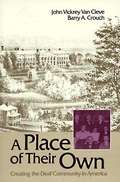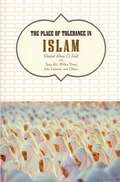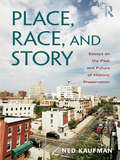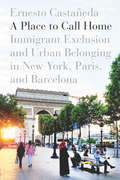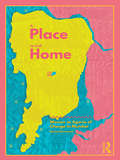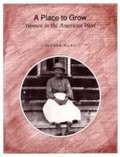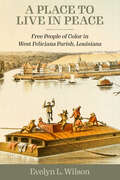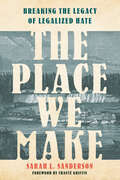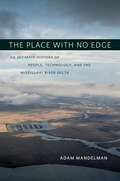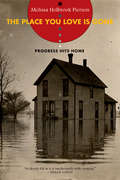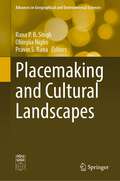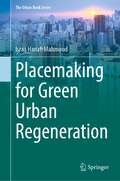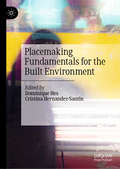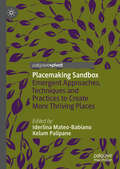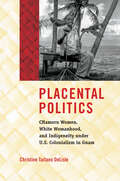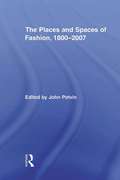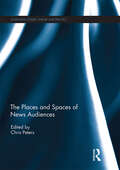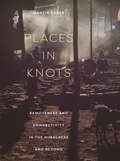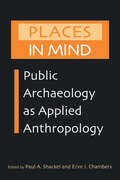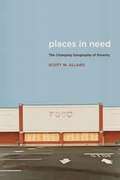- Table View
- List View
A Place of Their Own: Creating the Deaf Community in America
by John Vickrey Van Cleve Barry A. CrouchThe book is an attempt to provide a coherent look at important aspects of the process whereby deaf Americans became the American deaf community.
The Place of Tolerance in Islam
by Khaled Abou El FadlKhaled Abou El Fadl, a prominent critic of Islamic puritanism, leads off this lively debate by arguing that Islam is a deeply tolerant religion. Injunctions to violence against nonbelievers stem from misreadings of the Qur'an, he claims, and even jihad, or so-called holy war, has no basis in Qur'anic text or Muslim theology but instead grew out of social and political conflict.Many of Abou El Fadl's respondents think differently. Some contend that his brand of Islam will only appeal to Westerners and students in "liberal divinity schools" and that serious religious dialogue in the Muslim world requires dramatic political reforms. Other respondents argue that theological debates are irrelevant and that our focus should be on Western sabotage of such reforms. Still others argue that calls for Islamic "tolerance" betray the Qur'anic injunction for Muslims to struggle against their oppressors.The debate underscores an enduring challenge posed by religious morality in a pluralistic age: how can we preserve deep religious conviction while participating in what Abou El Fadl calls "a collective enterprise of goodness" that cuts across confessional differences?With contributions from Tariq Ali, Milton Viorst, and John Esposito, and others.From the Trade Paperback edition.
Place, Policy and Politics: Do Localities Matter?
by Michael Harloe C. G. Pickvance John UrryThe past ten years have seen local government in the UK facing two major challenges: to survive in the face of Thatcher government hostility, and to adapt to enormously powerful forces of economic restructuring which have also been encouraged by government policies. The key aspects of these changing fortunes of British towns explored in this important new book is the ability of individual localities to exercise any control over their own growth and decline. Place, Policy and Politics examines local political initiatives seeking to influence economic and social development in seven sharply contrasting localities, ranging from the outer council estates of Merseyside to the boom towns of Cheltenham and Swindon. Throughout their analysis, the contributors, drawn from a wide range of social science disciplines, address the vital questions in the debate over local policy initiatives, including: * To what extent are localities able to harness trends in the national and international economy to provide jobs and a better standard of living for their inhabitants? * Why do local authorities vary in their capacity to initiate economic policy? * To what extent do national urban and other policies inhibit or encourage their efforts? * How might central government modify its policies to facilitate the prospering of localities?
Place, Race, and Story: Essays on the Past and Future of Historic Preservation
by Ned KaufmanIn Place, Race, and Story, author Ned Kaufman has collected his own essays dedicated to the proposition of giving the next generation of preservationists not only a foundational knowledge of the field of study, but more ideas on where they can take it. Through both big-picture essays considering preservation across time, and descriptions of work on specific sites, the essays in this collection trace the themes of place, race, and story in ways that raise questions, stimulate discussion, and offer a different perspective on these common ideas. Including unpublished essays as well as established works by the author, Place, Race, and Story provides a new outline for a progressive preservation movement – the revitalized movement for social progress.
Place, Space, and Mediated Communication: Exploring Context Collapse (Shaping Inquiry in Culture, Communication and Media Studies)
by Carolyn Marvin Hong Sun-HaPlace, Space, and Mediated Communication explores how new communications technologies are able to disrupt our spatial understanding, and in so doing, reorganize the boundaries of human experience: a phenomenon that can rightly be described as ‘context collapse’. Individual essays investigate ‘context collapse’ in a variety of geographical and temporal settings, including: the US drone war in Pakistan, social media and sexuality in Paris, privacy and privilege in Brazil, and videogames and resistance in Iran. This cross-disciplinary collection of essays demonstrates how communication and space are co-constituted, and models exciting new paths of inquiry for researchers. Place, Space, and Mediated Communication is suitable for students and scholars of media and communication studies, cultural studies, urban studies, and sociology.
A Place That Matters Yet: John Gubbins's MuseumAfrica in the Postcolonial World
by Sara ByalaA Place That Matters Yet unearths the little-known story of Johannesburg’s MuseumAfrica, a South African history museum that embodies one of the most dynamic and fraught stories of colonialism and postcolonialism, its life spanning the eras before, during, and after apartheid. Sara Byala, in examining this story, sheds new light not only on racism and its institutionalization in South Africa but also on the problems facing any museum that is charged with navigating colonial history from a postcolonial perspective. Drawing on thirty years of personal letters and public writings by museum founder John Gubbins, Byala paints a picture of a uniquely progressive colonist, focusing on his philosophical notion of “three-dimensional thinking,” which aimed to transcend binaries and thus—quite explicitly—racism. Unfortunately, Gubbins died within weeks of the museum’s opening, and his hopes would go unrealized as the museum fell in line with emergent apartheid politics. Following the museum through this transformation and on to its 1994 reconfiguration as a post-apartheid institution, Byala showcases it as a rich—and problematic—archive of both material culture and the ideas that surround that culture, arguing for its continued importance in the establishment of a unified South Africa.
A Place to Call Home: Immigrant Exclusion and Urban Belonging in New York, Paris, and Barcelona
by Ernesto CastañedaAs immigrants settle in new places, they are faced with endless uncertainties that prevent them from feeling that they belong. From language barriers, to differing social norms, to legal boundaries separating them from established residents, they are constantly navigating shifting and contradictory expectations both to assimilate to their new culture and to honor their native one. In A Place to Call Home, Ernesto Castañeda offers a uniquely comparative portrait of immigrant expectations and experiences. Drawing on fourteen years of ethnographic observation and hundreds of interviews with documented and undocumented immigrants and their children, Castañeda sets out to determine how different locations can aid or disrupt the process of immigrant integration. Focusing on New York City, Paris, and Barcelona—immigration hubs in their respective countries—he compares the experiences of both Latino and North African migrants, and finds that subjective understandings, local contexts, national and regional history, and religious institutions are all factors that profoundly impact the personal journey to belonging.
A Place to Call Home: Women as Agents of Change in Mumbai
by Ramya RamanathAny city is a product of politics and economics, organizations and people. Yet, the life experiences of women uprooted from its poorest quarters seldom inform urban resettlement plans. In this ethnographic field study, Ramya Ramanath, Associate Professor at DePaul University, examines the lives of women displaced by slum clearance and relocated to the largest slum resettlement site in Asia. Through conversations with diverse women of different ages, levels of education, types of employment, marital status, ethnicity, caste, religion, and household make-up, Ramanath recounts how women negotiate a drastic change in environment, from makeshift housing in a park slum to ownership of a high-rise apartment in a posh Mumbai suburb. Each phase of their city lives reflects how women initiate change and disseminate a vision valuable to planners intent on urban and residential transformations. Ramanath urges the concerted engagement of residents in design, development, and evaluation of place-making processes in cities and within their own neighborhoods especially. This book will interest scholars of public policy, women and gender studies, South Asian studies, and urban planning.
A Place to Grow: Women in the American West
by Glenda RileyThese are essays focused on women and the frontier (abbreviated from the Foreword in the book). The Western History in the 1990s has research on western women that is rich, varied, and increasingly sophisticated. But answers to crucial controversies remain elusive. Did the American West offer women a place to grow? Did women find more economic opportunities in the West than elsewhere? Were western women more politically active and effective than their eastern counterparts? Did the West's reputed liberalism and democracy shape the lives of all western women for the better? Or did women of some social classes, races, and ethnic backgrounds face difficulty? I have selected ten essays that I have found especially useful in explaining the nature and importance of these issues. in the classroom as well as for audiences of both colleagues and laypersons. I have rounded out the selection with an essay written especially for this volume and with a large collection of primary documents. The result is a text that addresses these questions and, in the process, reveals both the complexity of research issues and the multiplicity of women's perspectives. These essays discuss and analyze a variety of topics concerning women's lives and experiences in the American West. Interspersed among the essays, the documents not only give the flavor of women's attitudes and reactions to issues of the day, but also demonstrate the importance of women's own words as historical evidence. The selections presented here, which explore gender, race, class, region, and other variables, are arranged in five sections: 1) stereotypes of western women, 2) women and westward trails, 3) women migrants and Native Americans, 4) women and work, and 5) women, adaptation, and change. Almost every type of western woman is represented, although archivists and scholars have only recently begun to retrieve other ethnic groups.
A Place to Live in Peace: Free People of Color in West Feliciana Parish, Louisiana
by Evelyn L. WilsonA Place to Live in Peace: Free People of Color in West Feliciana Parish, Louisiana reveals a community where free people of color lived harmoniously with white people even as slavery persisted. Author Evelyn L. Wilson documents the presence, land ownership, business development, and personal relationships of free people of color in this Louisiana parish. In the last decade before the Civil War, tensions over slavery in West Feliciana Parish, Louisiana, led to the separation of free people of color from their white counterparts. But until the 1850s, free people of color had lived and thrived there. The free people of color who inhabited West Feliciana Parish were not a settled population with a common background or a long history of freedom. Some entered the parish already free, others purchased their freedom, while others had been freed by slaveholders for differing reasons. Regardless of how they arrived in the parish, they found themselves in a community that valued the talents and skills they had to offer without regard to the color of their skin. These individuals were integrated into their community, lived among white neighbors, provided needed services, and owned successful businesses. Using extensive archival research, including court records, government documents, legal citations, and periodicals, Wilson interprets the lives, experiences, and contributions of free people of color in West Feliciana Parish. The integral role that these free people of color played in the parish complicates common understandings of the antebellum South.
The Place We Make: Breaking the Legacy of Legalized Hate
by Sarah L. SandersonA thoughtful investigation into the incredible true story of a Black man convicted and exiled under the Oregon Exclusion Law in 1851—and a contemporary White woman wrestling with racism and faith after learning she&’s a descendant of two men who assisted in the exile.&“A beautiful rendering of an ugly history. A worthy read.&”—Chanté Griffin, advocate, journalist, and authorMoving back to the outskirts of Portland, called the &“Whitest city in America,&” prompted Sarah&’s curiosity about the colonization of the West, her ancestors, and the legal exile of a Black man. She examined four city leaders involved in Jacob Vanderpool&’s case—Oregon City&’s founder, the case judge, Jacob&’s accuser, and a local pastor—and the cultural and theological fallout of their decisions. Along the way, Sarah took a hard look at her tendencies, unconscious and deliberate, to ignore the possibility of prejudice in her heart. Vanderpool&’s case proved a fascinating lens on a far bigger story than one trial, illuminating truths to help us all come to honest terms with our past, learn to repent, and contribute to the good of the people and places around us.Journey through this sensitive expedition into the events that remain a thorn under America&’s skin and discover afresh the vast potential of the flawed but endlessly redeemable—human heart.
The Place with No Edge: An Intimate History of People, Technology, and the Mississippi River Delta (The\natural World Of The Gulf South Ser.)
by Adam MandelmanIn The Place with No Edge, Adam Mandelman follows three centuries of human efforts to inhabit and control the lower Mississippi River delta, the vast watery flatlands spreading across much of southern Louisiana. He finds that people’s use of technology to tame unruly nature in the region has produced interdependence with—rather than independence from—the environment. Created over millennia by deposits of silt and sand, the Mississippi River delta is one of the most dynamic landscapes in North America. From the eighteenth-century establishment of the first French fort below New Orleans to the creation of Louisiana’s Coastal Master Plan in the 2000s, people have attempted to harness and master this landscape through technology. Mandelman examines six specific interventions employed in the delta over time: levees, rice flumes, pullboats, geophysical surveys, dredgers, and petroleum cracking. He demonstrates that even as people seemed to gain control over the environment, they grew more deeply intertwined with—and vulnerable to—it. The greatest folly, Mandelman argues, is to believe that technology affords mastery. Environmental catastrophes of coastal land loss and petrochemical pollution may appear to be disconnected, but both emerged from the same fantasy of harnessing nature to technology. Similarly, the levee system’s failures and the subsequent deluge after Hurricane Katrina owe as much to centuries of human entanglement with the delta as to global warming’s rising seas and strengthening storms. The Place with No Edge advocates for a deeper understanding of humans’ relationship with nature. It provides compelling evidence that altering the environment—whether to make it habitable, profitable, or navigable —inevitably brings a response, sometimes with unanticipated consequences. Mandelman encourages a mindfulness of the ways that our inventions engage with nature and a willingness to intervene in responsible, respectful ways.
The Place You Love Is Gone: Progress Hits Home
by Melissa Holbrook Pierson"Smart and defiant. Rich with characters and anecdote and heart. A great success." --Anthony Swofford, New York Times Book Review Has the futureever more people with their houses, stores, roads, and sprawlbeen wrecking your past? Melissa Holbrook Pierson, with unalloyed insight, elucidates how it feels to lose that landscape of home. In the past twenty years, like countless towns it resembles, Akron, Ohio, has lost its singularity, and much of what native-daughter Pierson loves about it. She then moves to Hoboken, New Jersey, a forgotten appendage of New Yorkuntil stockbrokers discover it. Finally, she speaks of rural areas, telling of the thousands of upstate New Yorkers displaced by city reservoirs. A unique book uniquely of our moment: This is what it feels like to lose the place you love.
Placemaking and Cultural Landscapes (Advances in Geographical and Environmental Sciences)
by Pravin S. Rana Olimpia Niglio Rana P. B. SinghPlacemaking and cultural landscapes are worldwide multidisciplinary global concerns that cover many points of view of the common impacts of socio-economic cultural and rights jurisprudence planning, wellbeing and related advancements. Concerned with the complex interactions between the development and environment of those factors, it is important to seek ways, paths and implications for framing sustainability in all social activities. This book is mostly based on the 10th ACLA – Asian Cultural Landscape Association International Webinar Symposium that took place during September 26–27, 2020, in the Banaras Hindu University, Varanasi, India. It examines contemporary social–cultural issues in the context of the United Nations Sustainable Development Goals (UN-SDGs) and associated cultural and sacred landscapes. There, the emphasis is on awakening deeper cultural sensitivity in harmonizing the world and the role of society and spiritual systems, drawing upon multi-disciplinary and cross-cultural interfaces—all within the scope of the future of the earth. The book’s chapters add a new dimension of cultural understanding in the broad domain of emerging human geoscience, considered as key policy science for contributing towards sustainability and survivability science together with future earth initiatives.
Placemaking for Green Urban Regeneration (The Urban Book Series)
by Israa Hanafi MahmoudThis book investigates the dynamics and the role of green urban regeneration using nature-based solutions (NBS) in contributing to the cultural aspects of public spaces. In the first part of the book, insights on analytical methods, planning strategies and shared governance examples are given, as well as, an assessment tool, namely public space index (PSI), is given for successfully measuring sociability impact while using a placemaking approach to green urban regeneration processes. In the second part, the case study (Rose Kennedy Greenway of Boston, MA, USA) has been extensively researched during many years of observations and analysis which gives a realistic taste of the implementation of the proposed PSI. The book’s last part reflects on PSI to measure its adaptability and replicability in other contexts, whereas NBS are playing a major role in physical and spatial green urban regeneration in current cities contexts’.
Placemaking Fundamentals for the Built Environment
by Dominique Hes Cristina Hernandez-SantinThis book is for all those actively working in the built environment. It presents the latest theory and practice of engaging with stakeholders to co-design, develop and manage thriving places. It starts from the importance of integrating design of nature into practice built on a foundation of First Nations understanding of place. The art of engagement of community, government and the development industry is discussed with reference to case studies and best practice techniques. The book then focuses on the critical role placemaking has in supporting resilience and adaptability of communities and looks at issues of leadership and governance. Building on these steps for placemaking, the last parts of the book address economics, evaluation, digital and art based tools and approaches to support projects that aim to create an engaged, contributive, collaborative and active citizen.
Placemaking Sandbox: Emergent Approaches, Techniques and Practices to Create More Thriving Places
by Iderlina Mateo-Babiano Kelum PalipanePlacemaking Sandbox offers a valuable collection of placemaking case studies, designed for teachers and students to build expertise in shaping and creating thriving public places. Each chapter outlines the latest research and practice underpinning placemaking pedagogical approaches, with specialist authors developing and interrogating methodological techniques and reflecting on current teaching and research. By taking a hands-on and experimental look at emergent practices, pedagogies and methods in placemaking across different contexts, this book will help deepen understandings on how to wrestle with complex conditions generated by place. In Placemaking Sandbox contributors skillfully tackle a little researched topic on the pedagogy of place and placemaking, and in the process offer a distinctive bridge between academia and practice.
Placental Politics: CHamoru Women, White Womanhood, and Indigeneity under U.S. Colonialism in Guam (Critical Indigeneities)
by Christine Taitano DeLisleFrom 1898 until World War II, U.S. imperial expansion brought significant numbers of white American women to Guam, primarily as wives to naval officers stationed on the island. Indigenous CHamoru women engaged with navy wives in a range of settings, and they used their relationships with American women to forge new forms of social and political power. As Christine Taitano DeLisle explains, much of the interaction between these women occurred in the realms of health care, midwifery, child care, and education. DeLisle focuses specifically on the pattera, Indigenous nurse-midwives who served CHamoru families. Though they showed strong interest in modern delivery practices and other accoutrements of American modernity under U.S. naval hegemony, the pattera and other CHamoru women never abandoned deeply held Indigenous beliefs, values, and practices, especially those associated with inafa'maolek--a code of behavior through which individual, collective, and environmental balance, harmony, and well-being were stewarded and maintained. DeLisle uses her evidence to argue for a "placental politics--a new conceptual paradigm for Indigenous women's political action. Drawing on oral histories, letters, photographs, military records, and more, DeLisle reveals how the entangled histories of CHamoru and white American women make us rethink the cultural politics of U.S. imperialism and the emergence of new Indigenous identities.
El placer de dormir sola: 64 rituales para ser la soberana de tu cama y de tu vida
by Cynthia Zak• Explica el alto poder energético, emocional y físico de contar con un espacio propio y sagrado para dormir• Describe paso a paso 64 rituales que elevan el valor de la experiencia onírica a solas para reencontrarte contigo misma, con tu cuerpo y con tu feminidad• Presenta el acto de dormir como un retiro espiritual para hallar respuestas a tus preguntas más íntimasLos apremios de la vida cotidiana te roban energía e intención. Dormir se ha convertido en un acto automático y rutinario: al final del día caes agotada en el lecho, sin darle relevancia. Nuestra cultura nos ha convencido de que compartir la cama es normal y deseable, como muestra de amor y cuidado hacia la pareja, los hijos y otras personas. Romper estos paradigmas y reclamar una noche para ti misma es una acción sublime para recuperar tu energía y tu poder, reencontrarte y volver a habitar tu cuerpo en consciencia absoluta, sin la invasión de vibraciones ajenas.En nueve capítulos, cada uno con siete rituales prácticos, accesibles y de diversas procedencias, Cynthia Zak te invita a ser la protagonista de la poderosa aventura de soñar. Conoce la biología de tu cuerpo al dormir y mantras de poder para calmar la mente, potenciar sueños lúcidos y mucho más, con el objetivo de redescubrir tu intuición femenina y propiciar una renovación integral. Aduéñate del descanso nocturno y transfórmalo en un retiro espiritual que impulse tu evolución como ser humano y como mujer.Cynthia afirma que al dormir sola &“el campo electromagnético de la inteligencia del corazón se expande, los centros de energía se balancean y las visiones son claras y hermosas, reforzando el poder de la intuición femenina&”. El mundo de los sueños se revelará ante ti para mostrarte que tú eres la persona más importante: mujer y diosa, soberana de tu cama y de tu vida.
The Places and Spaces of Fashion, 1800-2007 (Routledge Research in Cultural and Media Studies #16)
by John PotvinThe Places and Spaces of Fashion, 1800-2007 brings together art, design, fashion, and a much neglected concern for its spatial realities. The spaces and places of fashion have often been overlooked in the writing of fashion history and visual culture. More often than not, however, these environments mitigate, control, inform, and enhance how fashion is experienced, performed, consumed, seen, exhibited, purchased, appreciated and of course displayed. Space, as this volume attempts to illustrate, is itself a representational strategy on par with and influencing the visibility and visuality of fashion. Innovative and challenging, the essays in this volume explore various physical and conceptual spaces, moving from physical environments to the two-dimensional with paintings, illustrations, and photographs to chart similarities, differences, and complex nuanced relationships between environments, fashion, identities, and visuality. The volume also navigates various sites (both permanent and temporary) of production, circulation, exhibition, consumption, and promotion of fashion that define meaning and knowledge about a culture or individual by providing for a bond between embodied consumers/spectators and fashion objects. The Places and Spaces of Fashion, 1800-2007 is a compelling project with a thematic, theoretical, and historiographic approach that is at once both focused yet far-reaching and original in its implications. The volume engages with questions attending to the ‘modern condition’ by seamlessly weaving interdisciplinary discussions of the visual with material culture to explore the spatial dimension(s) of fashion. Some of the essays explore new and exciting spaces while others offer compelling revisionary analyses of relatively known sources
The Places and Spaces of News Audiences (ISSN)
by Chris PetersHistorically, or so we would like to believe, the story of everyday life for many people included regular, definitive moments of news consumption. Journalism, in fact, was distributed around these routines: papers were delivered before breakfast, the evening news on TV buttressed the transition from dinner to prime time programming, and radio updates were centred around commuting patterns. These habits were organized not just around specific times but occurred in specific places, following a predictable pattern. However, the past few decades have witnessed tremendous changes in the ways we can consume journalism and engage with information – from tablets, to smartphones, online, and so forth – and the different places and moments of news consumption have multiplied as a result, to the point where news is increasingly mobile and instantaneous. It is personalized, localized and available on-demand. Day-by-day, month-by-month, year-by-year, technology moves forward, impacting more than just the ways in which we get news. These fundamental shifts change what news ‘is’. This book expands our understanding of contemporary news audiences and explores how the different places and spaces of news consumption change both our experiences of journalism and the roles it plays in our everyday lives. This book was originally published as a special issue of Journalism Studies.
Places in Knots: Remoteness and Connectivity in the Himalayas and Beyond
by Martin SaxerTracing the experiences of mobile Himalayans across the globe, Places in Knots describes the ways in which Himalayan people relate to the multiple places they inhabit and the work and trouble of keeping their communities tied together. Martin Saxer describes global Himalayan ventures as a form of expansion of community rather than out-migration. Moving out does not sever the bonds of community. Instead, it is the pull that tightens the knot.Coffee-table books and trekking agencies continue to advertise the Himalayas as remote "hidden valleys," and NGOs see them as fragile mountain ecosystems to be protected from global forces of destruction. Places in Knots shows how these tropes of remoteness inform development and conservation policies and thus shape the contexts in which Himalayan connections with the wider world are forged and maintained. Following Himalayan journeys between valleys in Nepal and beyond, Saxer draws a picture of globalization that emerges not from the centers or below—but rather from the edge. Thanks to generous funding from LMU München, the ebook editions of this book are available as Open Access volumes from Cornell Open (cornellpress.cornell.edu/cornell-open) and other repositories.
Places in Mind: Public Archaeology as Applied Anthropology (Critical Perspectives In Identity, Memory, And The Built Environment Ser.)
by Paul A. Shackel Erve J. ChambersThis edited volume provides a cross-section of the cutting-edge ways in which archaeologists are developing new approaches to their work with communities and other stakeholder groups who have special interest in the uses in the past.
Places in My Neighborhood (My Neighborhood)
by Shelly LyonsA neighborhood has homes and stores. There are hospitals and libraries too. Which places do you see in your neighborhood?
Places in Need: The Changing Geography of Poverty
by Scott W. AllardAmericans think of suburbs as prosperous areas that are relatively free from poverty and unemployment. Yet, today more poor people live in the suburbs than in cities themselves. In Places in Need, social policy expert Scott W. Allard tracks how the number of poor people living in suburbs has more than doubled over the last 25 years, with little attention from either academics or policymakers. Rising suburban poverty has not coincided with a decrease in urban poverty, meaning that solutions for reducing poverty must work in both cities and suburbs. Allard notes that because the suburban social safety net is less-developed than the urban safety net, a better understanding of suburban communities is critical for understanding and alleviating poverty in metropolitan areas. Using census data, administrative data from safety net programs, and interviews with nonprofit leaders in the Chicago, Los Angeles, and Washington, D.C. metropolitan areas, Allard shows that poor suburban households resemble their urban counterparts in terms of labor force participation, family structure, and educational attainment. In the last few decades, suburbs have seen increases in single-parent households, decreases in the number of college graduates, and higher unemployment rates. As a result, suburban demand for safety net assistance has increased. Concerning is evidence suburban social service providers—which serve clients spread out over large geographical areas, and often lack the political and philanthropic support that urban nonprofit organizations can command—do not have sufficient resources to meet the demand. To strengthen local safety nets, Allard argues for expanding funding and eligibility to federal programs such as SNAP and the Earned Income Tax Credit, which have proven effective in urban and suburban communities alike. He also proposes to increase the capabilities of community-based service providers through a mix of new funding and capacity-building efforts. Places in Need demonstrates why researchers, policymakers, and nonprofit leaders should focus more on the shared fate of poor urban and suburban communities. This account of suburban vulnerability amidst persistent urban poverty provides a valuable foundation for developing more effective antipoverty strategies.
